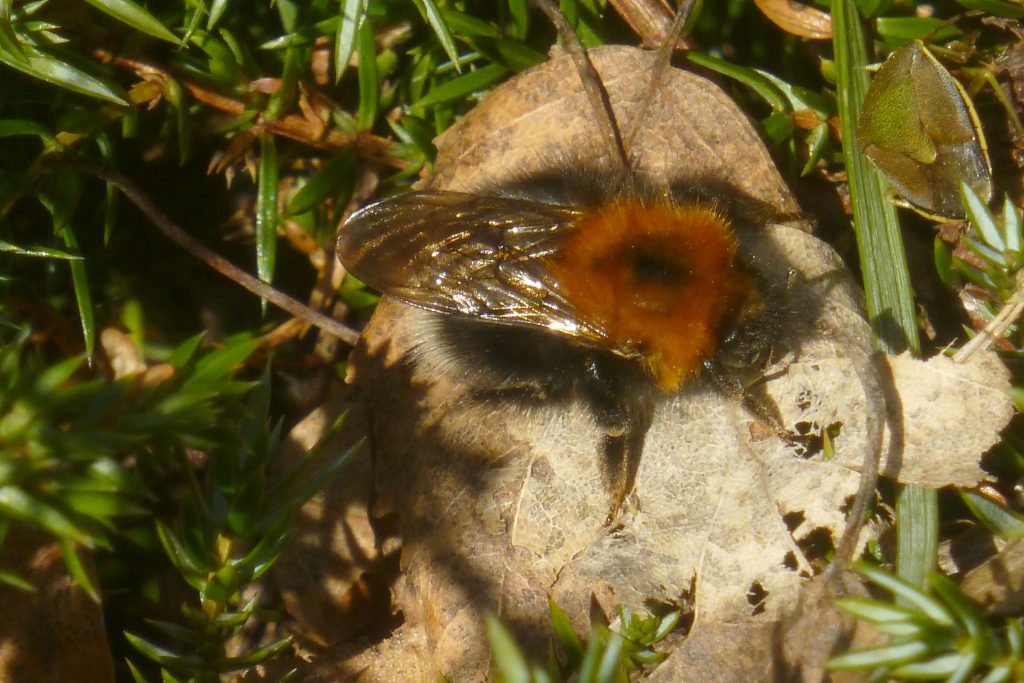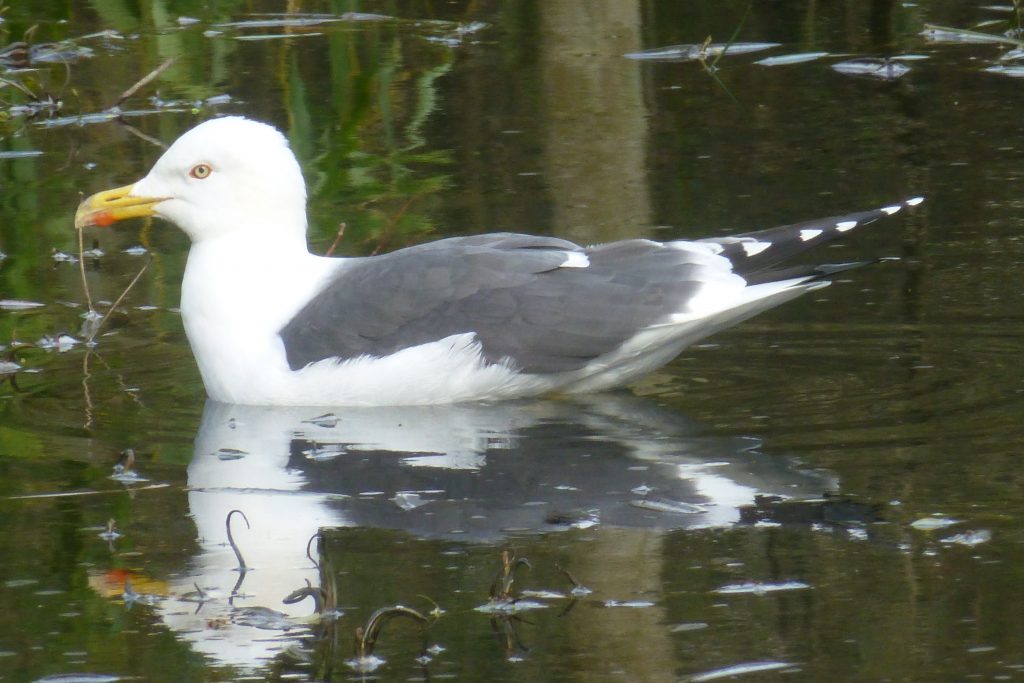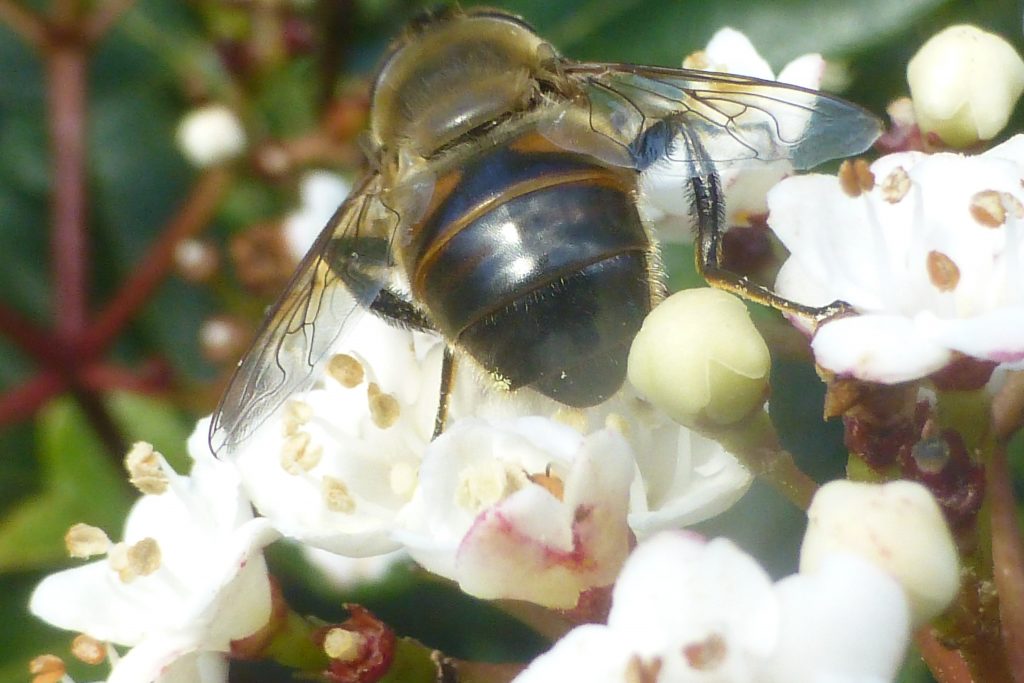March 2017 was mostly cool, sometimes distinctly chilly, and some light snow fell in the third week. Towards the end of the month, however, there was an abrupt change to very mild, even warm, spring-like weather with glorious sunshine. What rain fell was mostly at night or concentrated in short spells. Strong winds closed the Garden on more than one occasion. Four further species were added to the Garden’s wildlife list, taking it from 864 to 868. This was despite the principal wildlife recorder (me) taking partial retirement during March and the combination of a heavy teaching workload and reducing my working, and therefore wildlife recording, days from five to three per week.
Birds March was a pretty good month for birds in the Garden, with 40 species recorded. It marked a changeover between winter and summer migrants, with various arrivals and departures. Departures included Redwing, seen in the Garden from 1st–11th but not later; Pink-footed Geese, skeins of which flew northwards over the Garden on their way back to Arctic breeding grounds (12th and 15th), and Black-headed Gulls, which were not seen in the Garden after 9th, no doubt because they had gone to their breeding grounds elsewhere in the Lothians. Arrivals included Lesser Black-backed Gull from 1st, and Chiffchaff from 25th, with four singing by 30th in different parts of the Garden. Whether these were just passing through, or setting up territories, remains to be seen. A Goosander female was on the Pond on 23rd. Kingfishers were present on at least 16 dates (1st–9th inclusive, and seven dates between 19th and 30th); a pair was seen on several dates in the second period with a second female present on one of the dates. A Buzzard was seen by two observers on 6th, and three were seen on 25th, two of them ‘sky dancing’ after chasing off the third bird. Sparrowhawks, particularly a female, were active from 1st–9th and 25th–26th. The complete list of 40 species recorded during March 2017 was: Blackbird, Blackcap, Black-headed Gull, Blue Tit, Bullfinch, Buzzard, Carrion Crow, Chaffinch, Chiffchaff, Coal Tit, Dunnock, Feral Pigeon, Goldcrest, Goldfinch, Goosander, Great Spotted Woodpecker, Great Tit, Greenfinch, Grey Heron, Herring Gull, Jackdaw, Kingfisher, Lesser Black-backed Gull, Long-tailed Tit, Magpie, Mallard, Mistle Thrush, Moorhen, Oystercatcher, Pink-footed Goose, Redwing, Robin, Siskin, Song Thrush, Sparrowhawk, Stock Dove, Tawny Owl, Tree Creeper, Wood Pigeon, Wren.

Tree Bumblebee (Bombus hypnorum) resting on a leaf, Scottish Heath Garden, 1 March 2017. The combination of ginger thorax, black abdomen and white tail is unmistakable. Photo Robert Mill.
Insects and other invertebrates: In spite of the glorious warm sunshine towards the end of the month, no butterflies appear to have been recorded in the Garden during March, although due to my new work pattern it so happened that I was not there during that good spell of weather. The only moth seen was a Clouded Drab on 15th, although I suspect that if trapping had been done during the warm spell near the month’s end there would have been some good catches of early spring species. Honey Bees were once again out and about on all warmer days. Buff-tailed Bumblebee was seen regularly while there were two records of Tree Bumblebee (1st, 9th), and Early Bumblebee first appeared on 29th. Red-tailed Bumblebee was not recorded in March although one had been seen at the end of February, nor was Common Carder Bee, which might have been expected towards the end of the month, particularly as one of its favourite flowers (lungwort) was by then in full bloom in various parts of the Garden. A Black Ant on 30th was the first ant record of the year. The only hoverfly recorded was once again the drone-fly Eristalis tenax (2nd, 8th, 9th). Other fly records included the bluebottle Calliphora vicina (four dates), Phaonia tuguriorum (9th), Face Fly (Musca autumnalis) on 9th and 30th, and the year’s first Common Cluster-fly (Pollenia rudis) on 15th. Bugs included Forest Shield-bug (five dates in the first half of the month), the flower-bug Anthocoris cf. confusus (9th, a new Garden record) and the leafhopper Empoasca vitis (9th and 29th). Despite diligent searching on warmer days Gorse Shield Bug was not recorded in March but may well have been missed. Horticultural staff recorded several adults and larvae of the rapidly spreading, invasive Rosemary Beetle (Chrysolina americana) on sage and lavender plants between 28th and 30th. This was a new Garden record (maybe not a very welcome one; the Royal Horticultural Society has been informed) but there is a 2009 record of the same beetle species from Inverleith Park and there are other records from the Edinburgh area. Definitely one to keep a look out for, and under control, in your own gardens if you grow herbs such as sage, rosemary, lavender and others in the mint family Lamiaceae. Pine Ladybird was recorded twice (9th and 30th); strangely I have never seen it on pine, always on deciduous trees particularly beech. Barkfly records included Ectopsocus petersi on 1st, Epicaecilius pilipennis on 15th and Mesopsocus immunis on 30th. The springtail Entomobrya nivalis (7th and 23rd) was a new Garden record. Some small spiders and mites that remain unidentified might represent new Garden records; one that has been identified, and is the fourth new Garden record for March, was the so-called whirligig mite, Anystis baccarum on 30th. Finally, a Common Smooth Woodlouse was seen on a wall on 29th.


